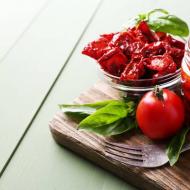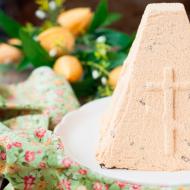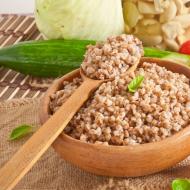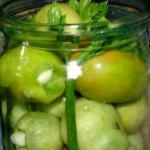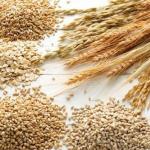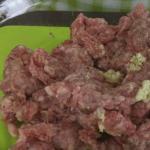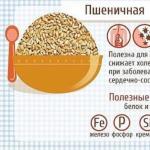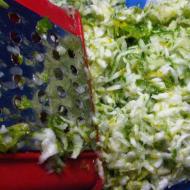
So that the cabbage does not darken when stewing. Stewed cabbage - the best recipes. How to quickly and step by step cook stewed cabbage. Stewed cabbage “Student style”
Stewed cabbage is one of the most popular dishes in Russian cuisine. Fresh or sauerkraut is stewed with mushrooms, sausages, carrots, potatoes, rice, beans or raisins. Season it with garlic, sour cream or tomato paste. Always different and very tasty, stewed cabbage never gets boring and is very beneficial for our body. It normalizes the functioning of the digestive system, removes toxins and reduces cholesterol levels. How to properly stew cabbage in order to preserve all the vitamins and nutrients?
Stewed white cabbage
To stew, make sure that the head of cabbage is tight and does not deform when pressed. It should also be beautiful, without spots, with fresh green leaves.
Now chop the onions, grate the carrots or chop them finely. Heat a small amount of vegetable oil in a frying pan, add the onions first, then the carrots and sauté the vegetables for 5 minutes until they turn golden. Chop the cabbage into strips or cubes, add to the vegetables and lightly fry for 5 minutes, then add a little water to stew the vegetables. Instead of water, you can add tomatoes or slightly sweetened tomato paste. Simmer young cabbage for up to 15 minutes, and winter cabbage for up to 40 minutes, until it becomes soft. Serve it with herbs, sour cream or mayonnaise, cold or hot.
How to stew red cabbage

Red cabbage is no less useful than white cabbage; it is chosen according to the same principle. In addition, good cabbage should have bright purple leaves. You can stew this cabbage without adding other vegetables - it will be delicious. Simply cut the cabbage into strips, sprinkle with salt, black pepper and nutmeg. Pour 3% vinegar (a couple of tablespoons per head) and simmer in a glass or ceramic bowl with a small amount of oil.
After an hour, when the cabbage becomes soft, season it with ketchup or tomato paste and serve as a side dish.
For a piquant and softer taste, you can add a little sugar, and replace regular vinegar with apple or rice vinegar. And one more secret - many housewives do not add salt immediately, but 10 minutes before the cabbage is ready. If you want to make the dish tastier, add wheat flour sauteed in oil at the end of stewing at the rate of 1 tbsp. l. flour for 1 kg of cabbage.
Stewed sauerkraut

If you do not make homemade preparations, then choose the right sauerkraut for stewing. It should be crispy, white-golden in color with a pinkish tint. A slimy and slightly viscous brine is also normal. Good cabbage has no stains, it has a sour-salty fresh taste, it is better if it is taken straight from the barrel. And one more important point - the larger the cabbage is cut, the more vitamins are preserved in it.
Stewed sauerkraut has a brighter and piquant taste, but before cooking it is washed in a colander with running water to remove excess acid.
Before stewing, sauté onions cut into half rings in oil, then mix them with cabbage and add a little water, seasoning with salt and black pepper.
After 45 minutes, add tomato paste, a little sugar and spices such as caraway or cumin to the cabbage. Simmer for another 5 minutes and remove from heat.
Stewed cauliflower

Cauliflower contains a lot of protein, so it must be included in the diet of vegetarians and athletes. In addition, this product activates mental activity and is indicated for nervous overload. When choosing cauliflower, make sure that its inflorescences are white and dense, without suspicious spots, and that the leaves are fresh and green.
Divide the head of cabbage into inflorescences, wash them thoroughly and cut into thin slices. Fry the cabbage in vegetable oil for several minutes, add salt, add tomato paste and water, then simmer for 15-20 minutes.
Season the cabbage with fresh herbs - parsley, basil or dill.
Stewed Brussels sprouts

Brussels sprouts are extremely rich in vitamin C, so they help maintain high immunity and performance. When buying cabbage, choose bright green, dense heads that are strong and small, as large ones can be a little bitter.
Brussels sprouts are good for stewing because they have a very pleasant taste and delicate aroma. True, there is a little secret - you need to first boil it for 5 minutes, adding a lemon drop to the water.
After this, the heads of cabbage are cut in half or into quarters and fried in oil with onions or leeks. Then the cabbage is seasoned with salt and pepper and stewed until soft. You can add a little sour cream mixed with water. Sprinkle the finished cabbage with grated cheese.
Stewed broccoli

Broccoli is valuable because it contains vitamin U, which protects against stomach ulcers. In addition, this type of cabbage is useful in the fight against tumors, and broccoli also has a beneficial effect on the heart and blood vessels. When choosing cabbage, make sure that the head is bright green, with dense, fresh leaves without damage.
Wash the broccoli, disassemble it into florets, remove the rough parts and place in a frying pan with well-heated oil. If the oil is not hot enough, the cabbage will turn out soft and brown. Simmer the broccoli for 20 minutes, seasoning it with salt and any spices.
In full screen



When cutting up cabbage before stewing, do not use the leaves adjacent to the stalk, as nitrates and radionuclides accumulate in them. If you are going to fry the cabbage before stewing, make sure that it is dry, otherwise the oil will splatter heavily during the frying process.
During stewing, make sure that the cabbage does not burn; add water if necessary, even if it is not written in the recipe for stewed cabbage. For frying, you can mix high-quality butter with vegetable oil - this will make the taste of the dish softer and more delicate.
To add some spice before frying, you can throw a pod of red hot pepper into the oil and lightly fry it, then remove it and simmer the cabbage in aromatic oil. Or you don’t have to remove it, just chop the pepper first - it all depends on whether you like spicy dishes. You can use garlic instead of pepper.
Cabbage is stewed not only in a frying pan, but also in a double boiler and in the oven at a temperature of 160-170°C, the duration of stewing is up to 40 minutes. In a multicooker, first use the “Frying” mode to sauté vegetables, and then use the “Stewing” mode; the time depends on the “age” of the cabbage. Do not overdo it with stewing, otherwise the dish will lose its vitamins and become too soft and tasteless.
The finished cabbage can be sprinkled with grated cheese and placed in the oven until the cheese melts and browns.

Now you will be surprised how simple and easy it is to stew cabbage and feed a large family with a tasty, satisfying, appetizing and cheap dish.
Ingredients: white cabbage - 1 kg, onions - 2 pcs., tomato paste - 2 tbsp. l., vinegar - 1 tbsp. l., sugar - 1 tbsp. l., flour - 1 tbsp. l., vegetable oil - 3 tbsp. l., bay leaf - 1 pc., salt and pepper - to taste.
Cooking method:
- Wash the cabbage and onions.
- Finely chop the cabbage.
- Place the cabbage in a bowl, add a glass of water and place on low heat.
- Pour 1 tbsp into the cabbage. l. vegetable oil.
- After 20 minutes, chop the onion into small cubes.
- Fry the onion in 1 tbsp. l. vegetable oil.
- At the end of frying, add tomato paste, sugar and one bay leaf to the onion.
- Mix fried onions with cabbage.
- Salt, pepper, add vinegar.
- After 10 minutes, fry the flour in 1 tbsp. l. oils
- Add flour to cabbage and stir.
- The total stewing time for cabbage is 40 minutes.
- Remove bay leaf before serving.
Serve the cabbage with mashed potatoes, rice, buckwheat or pasta, and complement the dish with a cutlet or goulash. Isn't it delicious?
Stewed Brussels Sprouts with Ginger Sauce

Cabbage goes well with spicy seasonings - this is how it is prepared in eastern countries.
Fry a glass of finely chopped onions in 1 tbsp. l. sesame oil until onion is soft, about three minutes. Now add 2 tsp to it. grated fresh ginger and 1 clove of finely chopped garlic. Fry for another 30 seconds.
Boil 450 g of Brussels sprouts in boiling water for 5 minutes, cut them into halves and place them in a frying pan with the onion and ginger. Pour ⅓ cup chicken broth over the vegetables and simmer for another 5 minutes.
Place the finished cabbage on a flat dish, pour over soy sauce and sprinkle with any fresh herbs. A healthy and flavorful side dish for meat and fish is ready!
Stewed cauliflower with tomatoes and bell peppers

This dish will surprise you with its pleasant taste and ease of preparation. Even a beginner in cooking can handle it!
Cut 3 onions into half rings and fry them in vegetable oil with 2 cloves of chopped garlic. Next, add 5 bell peppers, chopped into strips or cubes, grated carrots to the onion, and then fry the vegetables for 5 minutes.
Pour boiling water over 5 tomatoes, peel them, cut them into cubes and add them to the vegetables. Salt and pepper the dish, add chopped basil and oregano, a bunch of finely chopped parsley and 300 g of cauliflower, disassembled into inflorescences. Simmer for another 10 minutes and serve with boiled potatoes.
Broccoli in orange sauce

You can't even imagine how amazing the combination of broccoli and citrus fruits is, so orange sauce is the perfect addition to this dish.
First prepare the sauce. Remove the zest from 1 orange and cut it into small thin strips. Squeeze the juice from the orange. Heat 1 tbsp in a frying pan or saucepan. l. olive oil, throw in orange zest and a third of a glass of walnuts. Fry the ingredients for 2 minutes.
Serve cabbage with toasted bacon and chili.
Try all types of stewed cabbage, experiment with different products and spices. You'll soon realize that cabbage is the perfect dish for culinary experimentation, especially if you're a novice cook!
***
Cabbage. Culinary tricks
To preserve vitamins in cabbage, it is recommended not to
boil it and simmer it.
Cabbage will retain its appetizing whiteness if the water where it is boiled is
add a teaspoon of lemon juice or a few lemon crystals
acids.
It is better to boil cabbage in an enamel bowl over high heat.
Do not salt cabbage prepared for minced meat: a lot of liquid will be released and the minced meat will be raw.
If the cabbage is over-acidified, rinse it warm before eating.
boiled water and squeeze lightly. If it is slightly peroxidized -
rinse in cold water.
Cabbage fermented with whole heads of cabbage will be tender and elastic if the rows of heads of cabbage are sprinkled with coarsely crushed corn grains.
To remove small pests from a cabbage head, soak it in salt water.
Provencal cabbage is prepared shortly before consumption, as it
Even in a cool room it can only be stored for 2-3 days.
When cooked, cauliflower acquires a yellowish or grayish tint.
To make it white, place a slice in the water in which the cabbage is boiled.
lemon. Cabbage cannot be cooked in tin or aluminum containers, as
it also ruins its color. It is better to cook in an enamel pan.
Boiled cauliflower is considered ready if the knife fits freely into the stalk.
The stalk is first removed from the cabbage and then cut into strips
about half a centimeter to a centimeter (unless otherwise indicated in the recipe).
In order for the cauliflower to remain white, it must first be placed in
cold water, acidified with citric acid or vinegar, then this
Drain the water and place the cabbage in lightly salted boiling water. Brew in
open container for no more than one or two minutes on high and then on low
fire.
The unpleasant, pungent smell of white cabbage will evaporate if you cook it in an open pan for a while.
A little vinegar or citric acid is added to stewed fresh cabbage to prevent it from becoming too soft.
Fresh cabbage should never be fried. When fried it becomes
dry and tasteless. Therefore, they first boil it and then fry it.
In order for it not to darken and maintain a beautiful white color, you need
Place a piece of sugar into the water as it boils. For fillings
chopped raw cabbage is doused with boiling water before frying.
An unpleasant odor during cooking cabbage can be eliminated by placing bread crumbs wrapped in a clean rag in the pan.
A clean rag soaked in vinegar and placed on the lid of the pan will also eliminate the unpleasant smell of cabbage in the kitchen.
To prevent cabbage rolls placed in a stewing pan from burning, place on the bottom
For pans, place a lid with a smaller diameter than the pan, with an eye
up. Place cabbage leaves on the lid, and on them - layer by layer -
cabbage rolls
Early varieties of cabbage are not shelf stable, but contain significantly
more vitamins than later varieties. This cabbage is best used in
raw for salads.
When stewing cabbage rolls, you do not need to pour a lot of water or broth - the cabbage rolls will turn out too watery and tasteless.
Savoy cabbage is prepared according to the same recipes as white cabbage.
It is better to stew cabbage with vinegar, then it will not be too soft. - - - Cauliflower can be stewed in milk.
White and red cabbage can be fermented using the same methods.
recipes and for marinating use the same filling
The most rational methods of preparing hot vegetable dishes from the point of view of preserving vitamins are stewing or simmering in a small amount of water.
Braising is a long process. The vegetables give off some of their flavor to the liquid in which they are stewed, and this becomes the gravy for the dish. Stew vegetables in a sealed container over low heat.
Most often cabbage and potatoes are cooked this way, but all root vegetables, zucchini, pumpkin, eggplant, sweet peppers, tomatoes and mushrooms can be stewed. Spinach, fennel and many other vegetables are also stewed.
Stewed vegetables of the same type are often served as a side dish. A mixture of vegetables usually turns into a separate dish. For example, a vegetable stew, in which a different set of vegetables is possible. When cooking, they should not be placed in the pan at the same time, but taking into account the final cooking time of the dish.
Vegetables at a low temperature
When several types of vegetables are stewed, their flavors mix. The taste of carrots, beets, and small white onions is emphasized by glazing - stewing with sugar, butter and spices in a small amount of water. Stewing in dry wines allows vegetables to remain elastic longer. And the long cooking time allows the flavors to mingle.
For dishes with onions and leeks, both white and red wine are suitable; for vegetables with a less pronounced taste, such as zucchini, white is more suitable. To thicken the wine sauce, you can add a little flour to them before pouring the wine in a thin stream into the cooking vegetables.
Stewed white cabbage
Cabbage must first be stewed in a small amount of water, then add fat. To prevent the cabbage from darkening during stewing, add a piece of sugar to the water at the moment of boiling, and if you add citric acid (at the tip of a knife) or 0.5 teaspoon of fruit vinegar, the cabbage will soften less.
Stew the cabbage for 30–40 minutes, then add fried onions mixed with tomato sauce or fresh tomatoes, bay leaves, a few black peppercorns, salt, a little vinegar, 2–3 cloves and a little sugar. After this, the cabbage is stewed for another 5–10 minutes.
You can stew cabbage with carrots, but without vinegar. Carrots do not combine with vinegar, which destroys carotene.
Root celery with tomatoes
Celery root is cut into cubes and fried in oil. Combine with peeled, finely chopped tomatoes, add salt, flour and simmer. Add sour cream, parsley and dill to the finished dish.
Ingredients for 1 serving: 120 g celery, 100 g tomatoes, 15 ml vegetable oil, 5 g flour, sour cream, parsley, dill, salt to taste.
Pumpkin with apples
Sweet pumpkin is cut into cubes, placed in a saucepan with a small amount of water, added some salt and simmered under the lid until the pumpkin softens, butter is added, poured with milk or cream and evaporated. Before serving, sprinkle with finely chopped fresh apples of sweet and sour varieties or fresh berries, you can add sugar to taste.
Ingredients for 1 serving: 120 g pumpkin, 20 g apples, 10 g butter, 60 ml milk, sugar to taste.
Stewed peppers stuffed with rice and vegetables
Choose thick-walled, cube-shaped peppers that will stand up in the bowl without tipping over. Cut off the stems and set aside. Remove seeds and membranes from the fruit. Scald the peppers, place the filling tightly inside and cover each pepper with its base. Place the pepper in a deep heat-resistant bowl, pour in meat (beef) or vegetable broth, add a couple of bay leaves, cover with a lid and simmer for 20 minutes in the oven at 200°C.
Filling. Finely chopped stewed vegetables - onions, carrots, peeled tomatoes, parsley, you can add nuts - mix with pre-soaked rice for 2 hours and then scalded.
Zucchini, eggplant, special varieties of tomatoes, and onions are also suitable for stuffing and stewing.
Glazed shallots
Melt the butter in a deep frying pan, add peeled small (about 3 cm in diameter) shallots and salt to taste. Simmer over low heat, covered, until the onions soften. Then remove the lid and continue to simmer until the onions are browned. Shake
frying pan, but do not stir the onions so that they do not fall apart.
Sprinkle the onion with granulated sugar (1 tablespoon) and simmer for a few more minutes over very low heat. The butter and sugar mixture should turn golden brown. To prevent the dish from burning, add water by spoonfuls. Tilt the pan in different directions so that the onions are completely covered with syrup.
Serve hot.
You can also use small onions, but shallots are less spicy, more aromatic and have thin, juicy scales.
This is a gourmet dish; Muriel Barbery's novel A Delicacy contains a more sophisticated recipe for glazed shallots.
Almost every experienced housewife knows many ways to stew cabbage in a frying pan. Cabbage is an excellent source of fiber, vitamins and microelements. It is traditionally used in Russian and many other national cuisines. This dish is used as a main dish during Lent, as a side dish for meat and fish, and as a filling for pies. By adding different spices, vegetables and other ingredients you can achieve completely different tastes of the same dish. Fresh and pickled white cabbage, Savoy, Chinese, cauliflower and broccoli are stewed.
First you need to choose a suitable head of cabbage in the store. It should be hard, dense, white, without spots of rot and very thick veins at the base. It is better to choose flat heads of cabbage, as they are more tender and juicy. You can store cabbage in the vegetable compartment of the refrigerator.
Before use, cut out the top loose leaves, then wash it, cut it into quarters and remove the stalk. Each part is cut into thin strips or a shredder is used to chop; all thickenings and veins should be removed. In this form, the vegetable is ready for further cooking. All types of cabbage are prepared in the same way.
The sauerkraut should be placed in a colander to drain off excess brine; if it is sour, you can rinse it with water.
Classic way
To prepare this dish, you need to take a deep frying pan with a thick bottom; during frying, the vegetable greatly decreases in volume.
For 1 kg of cabbage you will need 1 small carrot and onion, a couple of tbsp. l. sunflower or any vegetable oil, half a glass of water, bay leaf, salt, ground black pepper to taste.

Heat vegetable oil in a frying pan, add diced onion and fry until transparent. Chop the carrots into not very thick strips and add to the pan, stir and fry until the vegetables become slightly golden. Place the chopped cabbage in a heap in a frying pan on top of the sauteed vegetables, add water, salt and seasonings, cover with a lid and turn on the burner at full power. After 5 minutes, when the cabbage is steamed, remove the lid, reduce the burner power a little and, stirring, fry until done.
How long to stew cabbage depends on its variety and maturity. Usually 20 minutes is enough. Towards the end of cooking, it will begin to turn brown and become soft, but will retain its shape. At this stage, you need to taste whether there is enough salt and spices, and determine the readiness of the dish. Can be served as a side dish for meat or baked fish.
If you need to get a more dietary version of the dish, then you can not add vegetable oil at all when stewing. Place shredded cabbage in a heap in a frying pan, finely chopped onions and carrots on top, add a glass of water, salt, cover with a lid, and let simmer for about 10 minutes. Then open the lid and simmer until done. Cabbage prepared in this way will remain light in color at the end of cooking. If you wish, you can add a little tomato at the beginning, then the dish will acquire a dark brown tint at the end of cooking.
Stewed cabbage with potatoes
This delicious and inexpensive traditional dish is very easy to prepare. In a frying pan in oil, fry the potatoes cut into medium cubes until golden brown and remove them. In the same oil, stew the cabbage in the usual classic way. At the end of the stew, add the previously cooked potatoes, add a little tomato, and leave everything together to simmer over low heat until done.

You can also cook lazy cabbage rolls in a frying pan. It's practically the same stewed cabbage, but the added ingredients give it a different taste.
For 300 g of ground beef, take half a glass of rice and sour cream, 1 kg of cabbage, 3 tbsp. l. tomato puree, 1.5 cups water, 2 tbsp. l. vegetable oil, salt and spices to taste.
Fry finely chopped onions and carrots in oil, add minced meat to them and simmer everything a little. Mix together tomato, water, sour cream, salt and spices. Add raw washed rice to the fried minced meat, pour in the sauce, and let it boil. Now you can add the diced cabbage, mix all the ingredients, cover with a lid and simmer over low heat until done for about half an hour. The finished dish can be sprinkled with fresh herbs and finely chopped garlic.
Dry borscht
This dish, made in a traditional Russian style, is very filling and tasty.
Ingredients:
- white cabbage - 1 kg;
- pork ribs - 500 g;
- pork belly - 200 g;
- potatoes - 500 g;
- flour - 1 tbsp. l.;
- onion, carrot, bell pepper - 1 pc.;
- sugar - 1 tbsp. l.;
- tomato paste - 3 tbsp. l.;
- water - 1 glass;
- salt, ground black pepper, herbs, garlic, bay leaf - everything to taste.
Place finely chopped brisket in a dry, heated frying pan with high sides and wait until the fat is rendered, add onions, carrots and peppers chopped into small cubes, and fry everything. Cut the pork ribs into portions and add them to the vegetables, add half a glass of water, and simmer over low heat until half cooked.

Cut the potatoes and cabbage into medium cubes, place them on top of the meat in a frying pan, add tomato paste, salt, sugar and spices diluted in the remaining water, cover with a lid and leave to simmer over very low heat for 1 hour.
In a dry frying pan over high heat, fry the flour until golden brown and add to the main dish at the end of cooking, mix well, add chopped herbs and garlic, turn off the heat. Wrap the finished dish so that it simmers for another 3 hours. You can serve with sour cream.
Stewed young cabbage
The preparation of this dish is slightly different, since the leaves of young cabbage are very tender and do not require long stewing.
Place coarsely shredded cabbage in a high, heated frying pan, cover with a lid and let steam for about 5 minutes. When it begins to quickly decrease in volume, losing water, open the lid, add vegetable oil, salt and spices, stir and fry at full burner power for 3-5 minutes. If desired, you can add beaten eggs a few minutes before cooking.

If you add finely chopped boiled eggs and green onions to cooled cabbage, you will get a delicious filling for pies and kulebyaki.
Some general tips on how to deliciously stew fresh cabbage:
- Choose elastic, ripe heads of late varieties for stewing.
- It must be simmered over low heat, otherwise it will turn out to be tough and bitter in taste.
- If the cabbage has released too much juice, you can drain it, otherwise it will become very soft during the stewing process.
- When stewing with meat, you should first cook it until half cooked, and then add the main ingredients.
- Prunes, dried apricots or raisins added when stewing cabbage will add a touch of piquancy to the dish.
- Cabbage, neutral in taste, absorbs the aroma of additives. Therefore, you can prepare a new dish of stewed cabbage every time, varying with different ingredients, seasonings and spices. Add turmeric, coconut milk and chicken to create an Indian style dish. Adjika or tkemali will add Caucasian notes, and soy sauce and ginger will add oriental notes.
- To make the stew tastier, you can finish it in the oven, leaving it for 40 minutes at low power.
- During fasting or for vegetarians, you can use stewed cabbage as a main dish, adding dried or fresh mushrooms, beans, and rice when cooking.
Since cabbage was previously preserved for the winter only in pickled form, this dish has remained popular in the cuisines of many countries to this day. In Germany they stew sauerkraut with Bavarian sausages, in Russia with brisket, in Poland and Western Ukraine with lard and smoked sausages.
Moscow solyanka made from sauerkraut in a frying pan
To prepare this dish you will need: 1 kg of squeezed sauerkraut, 300 g of raw or smoked brisket, 1 onion, 2 medium pickled cucumbers, 2 tbsp. l. tomato puree, 1 tbsp. l. sugar, half a glass of cucumber pickle, 300 g of sausages.
Melt the fat from the chopped brisket in a frying pan, fry the onion in it, add cabbage and cook over high heat. Then add cucumbers, grated on a coarse grater, sausages cut into slices, pour in tomatoes diluted in brine, add sugar, cover with a lid and simmer over low heat for 20 minutes. Taste for salt before adding; you may not need it. Serve with sour cream, olives and a slice of lemon.

In Poland they prepare a similar dish called bigos. There are a lot of options for preparing it, but the main ingredients are sauerkraut, several types of meat and smoked sausages. Traditionally, this dish is simmered for many hours over very low heat, or preferably in the oven.
Other stewing methods
Savoy resembles young white cabbage, it is just as tender and cooks quickly.
For example, stewed cabbage in a frying pan or Italian-style savoy cabbage.
Ingredients:
- 2 tbsp. l. olive oil;
- 1 onion and celery stalk, diced;
- one and a half glasses of tomato puree or fresh tomatoes, pureed in a blender;
- 1 glass of water;
- 1 small head of cabbage;
- half a glass of rice;
- 1 tsp. sea salt;
- lots of grated parmesan.
How to cook:
- Heat olive oil in a heavy skillet over high heat. Add the onion and celery, stir and cook for about 3 minutes until the onion begins to become translucent.
- Remove the stalk from the cabbage and chop it into thin strips.
- Meanwhile, add the tomato puree to the celery and onion and simmer for about 7 minutes.
- Add cabbage, salt and pour water. Stirring frequently, bring to a boil.
- Add the washed rice and let it simmer, covered, until done.
- Open the lid, increase the power of the burner and stir quickly until the remaining liquid evaporates.
- Serve the Italian dish with plenty of grated Parmesan cheese.
Purple cabbage tastes similar to regular cabbage, but it is drier and thicker, so it takes longer to cook.
Cabbage is stewed like white cabbage, but with the addition of double the amount of water, vinegar and honey; the best spices are cumin and dried dill. This cabbage should be simmered over low heat for about an hour. The prepared dish is ideal as a side dish for baked pork knuckle or grilled pork sausages.
Stewed cauliflower in a frying pan
Divide cauliflower weighing about 1 kg into inflorescences and place in a heavy frying pan, add half a glass of liquid, cover with a lid and simmer for 5-8 minutes until it becomes a little softer. Then add 80-100 g of butter and fry until slightly golden brown. Then add half a glass of sour cream, salt to taste and a lot of freshly ground black pepper to the dish being prepared, cover with a lid and simmer, at the end of cooking add 100 g of grated hard cheese. This dish is delicious both hot and cold. You can cook broccoli in exactly the same way.

You can prepare stewed cabbage in different ways. This nutritious dish is one of the most economical ways to cook, plus it's incredibly delicious and never gets boring. And how to stew cabbage in a frying pan, there are many recipes for this.
Video - how to deliciously cook stewed cabbage


